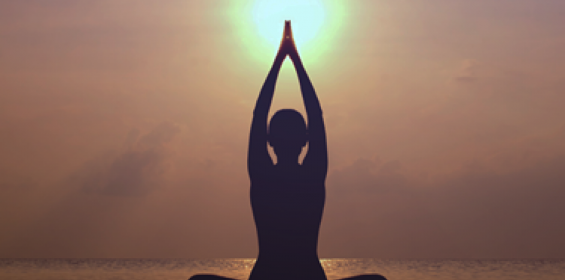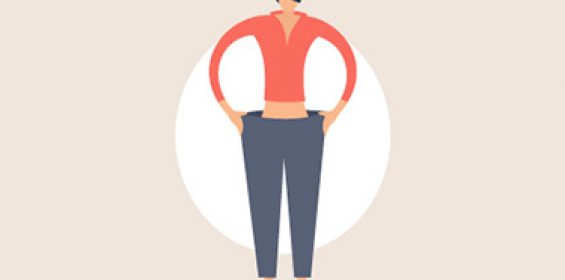By Nikita Singh┃Posted: January 07, 2019
We're just beginning 2019. Let's begin the New Year by asking ourselves, "What would I do if I wasn’t afraid?" In this article, I've shared what some of my fears were, and how I navigated the anxiety that came with these fears.
What if?
Here’s an incident from the days when I was a schoolgirl in pigtails: there were 5 stray dogs in the area. One evening, way after sunset, as I walked back home after a game of badminton with friends, the dogs appeared, and began to chase me. I froze, and then ran. My heart rate went up, and with this there was a quick, automatic sequence of physical reactions.
After this, each time I walked back home post sunset, I felt worried. I would panic with the thought of, “What if the dogs chase me again?” In other words, I was anxious that I would have to experience the same situation again! Although the dogs didn’t chase me once after that, the feeling of anxiety and fear remained.
Now that I reflect back on my life, and/or look at others’ life experiences, I find that a lot of us live in the world of ‘what if.’ What if I fail? What if it doesn’t work out? What if I get the promotion…will I actually be able to deliver? What if xyz doesn’t love me?
Time and again I’ve asked myself this question too… until recently when I re-read (for perhaps the 5th time), the book Lean In by Sheryl Sandberg. She asks a powerful question in the book: what would you do if you were not afraid?
I took some time off about 6 months ago to ask myself this question – “What would I do if I wasn’t afraid?”
1. Make lifestyle shifts (especially when in social settings – food and alcohol).
Why was I afraid? I had social anxiety. In a world where all of us want to be liked, my imagined fear about making lifestyle changes was, “What will my friends say/do/think/feel?” When I considered changing my diet and giving up drinking, I wondered whether I would still ‘fit in?’
2. Play more golf.
Why was I afraid? Because of remembered childhood experiences. I wasn’t ever really the best at sports in school. I considered golf a sport. My self-image was that I could excel in academics and other activities, but not sports. It was time to change this.
3. Make that exciting career transition (work towards setting up my own venture combining my passion for psychology with yoga, lifestyle, and total well-being).
Why was I afraid?
- Letting go of a sense of security was almost like letting go of my identity.
- The persistent mental pattern “I can only succeed if someone is leading me.”
- Fear of failure or ‘imperfection.’
Six months later, as I write this, I have made big changes in these three areas, and yes, it’s challenging. I’m still learning, and have a long way to go.
As I’ve made these changes, I’ve understood and experienced the depth in Marianne Williamson’s words: “It’s our light, and not our darkness that most frightens us.” Each time someone is inspired by a lifestyle change I’ve made, or I hit a good golf drive, or I make progress in my own practice, the first thoughts I have are “Is this real?” and “Will this last?” It’s in these moments where I remind myself – it’s my light, and not my darkness that frightens me…and the only way to overcome my fears is to face them.
While facing my fears, here are three lessons that stood out for me:
Personality matters: Your colleague and you could be in the same situation, yet react very differently. Personality traits refer to dispositional ways of thinking, feeling and acting, that show individual differences across situations. Of the big five personality traits, the trait of neuroticism has the highest correlation with feelings of anxiety and fear. If you’re high in trait neuroticism (TN), it means that you’re: 1) sensitive to stressors, 2) likely to have more frequent activations of negative emotions; 3) reactions that are more likely to be intense; and 4) reactions that last longer, so it takes longer to return to baseline.
However, it’s not always doom and gloom. Research has discovered the ‘healthy neurotic’ type, individuals that will channel their worry into positive behaviors, such as going to the gym, eating healthy, or meditation. Also, such people tend to be highly perceptive, with the inherent ability to tune into others’ emotions.
So, if you think you’re on the higher side of TN, look at how you can manage this. Also, don’t miss out on the strengths that come with it! On the lower side of the TN scale, that’s great – keep calm and carry on (but don’t be complacent!) Most importantly, don’t judge yourself for feeling (or not feeling) worried. A lot depends on our inherent traits – let’s accept who we are, become aware, and then leverage our strengths, as well as channel negative emotions into positive behaviors.
Being mindful: The simplest way to understand this new buzzword, mindfulness, is ‘a mind in the present moment.’ So simple, yet one of the toughest states to achieve. On average, human beings have 60,000 thoughts a day. This implies that a lot of our thoughts are linked, either to past memories or the future. Now, a mind that is oscillating between the past and the future is probably experiencing significant levels of anxiety and fear (whether it manifests in the form of neuroticism or not).
I found that being ‘in the moment’ (aka mindful) helped me navigate this gnawing feeling of anxiety. Mindfulness allows fear to be, just as it is, without diving in. Being in the present and immersed in each moment actually doesn’t give us the opportunity to over-think or worry.
Regular meditation, spending some time in nature, walking, focusing on our breath, zooming out to look at the bigger picture, are all ways to help one remain mindful. I apply the ‘RAIN’ model to my everyday situations:
R – Recognize and acknowledge what is happening.
A – Accept it as it is, i.e. don’t fight it or ignore it.
I – Investigate the physical sensations, thoughts and feelings within you. Don’t ask why, just observe and be 100% aware.
N – Non-identification. This process as a whole should bring you some distance from whatever is going on, an understanding that you’re more than this single feeling or experience.
Mindfulness may not completely eliminate our anxiety; however, it’ll help us act despite the fear.
Anxiety has both mental and physical implications: Often, we know what to do, and ‘train’ our minds, because we understand the psychology of our fear. Yet, we continue to experience anxiety. This is because of the physiological changes we experience in the body – some of them being an increase in heart rate, faster breathing, activation of the sympathetic nervous system leading to slow digestion and release of stress hormones.
However, there’s a silver lining – while anxiety can cause these physiological reactions, the reverse is true as well. Taking the right action to reverse the impact on our physiology can help restore the balance and calm in our mind. For example, consciously taking long deep breaths helps to activate the parasympathetic nervous system and reduce the release of stress hormones.
We can restore our balance to an extent that even if you’re very high on the neuroticism scale, you’ll learn to feel a sense of calm!
Bottom line: It’s critical we ask ourselves, “What would I do if I wasn’t afraid?” But, is asking ourselves enough? Probably not. So, use the three tools – know your personality, be mindful, and manage the physiological responses that come with anxiety!
This article was originally published by The Thrive Global Community and is re-posted here with the author’s permission.
Nikita Singh, an organizational psychologist, a certified health & wellness coach and a leadership consultant, and the founder of The Human Prism, has worked internationally in diverse industries with a keen interest in holistic, individual development.


































